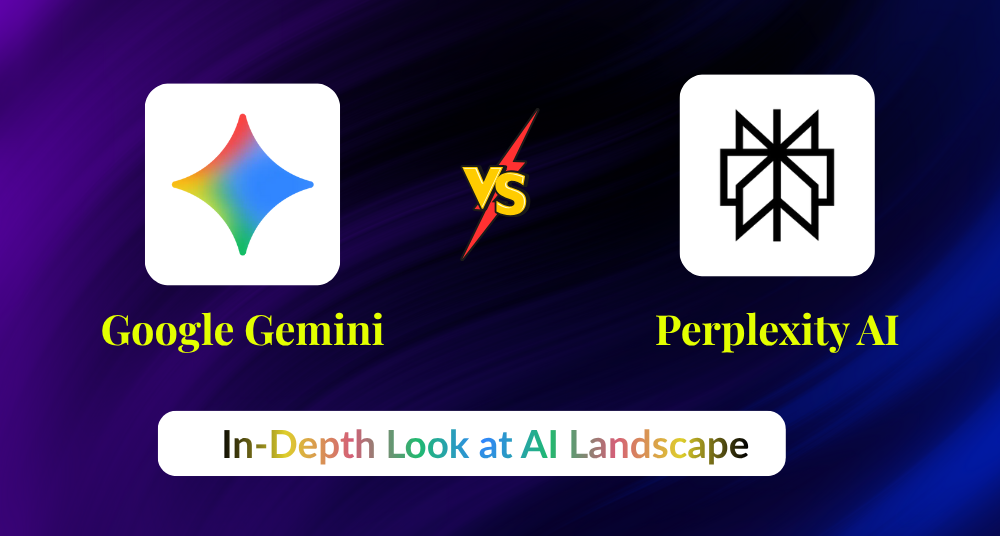The battle of advanced AI tools is heating up, and one of the most talked-about comparisons today is Google Gemini vs Perplexity AI. Both represent cutting-edge innovations but cater to different aspects of artificial intelligence. Google Gemini, developed by DeepMind, is a powerful multimodal model designed for reasoning, coding, and integrating text, images, and audio. In contrast, Perplexity AI focuses on delivering fast, accurate, and cited answers by merging generative AI with real-time web search.
These two platforms redefine how we interact with technology — one through deep analytical capabilities and the other through transparent, knowledge-driven insights. In this article, we’ll explore how Google Gemini vs Perplexity AI compare in features, performance, accuracy, and ideal use cases.
What is Google Gemini?
Originally announced by Google (and its AI research arm Google DeepMind) as “our most capable AI model yet”, Google Gemini was built from the ground up to be multimodal — meaning it can understand, integrate and reason across different types of input (text, images, audio, video, code) rather than just plain text.
Key features & milestones
- The first widely-released version, Gemini 1.0, was optimized into three “sizes”: Ultra (largest), Pro (mid-capability) and Nano (efficient on-device).
- According to Google, Gemini Ultra achieved state‐of‐the‐art results on many academic benchmarks including text, coding, multimodal reasoning and image understanding — for example outperforming human expert-level on the MMLU (Massive Multitask Language Understanding) benchmark.
- In Feb 2024, Google announced Gemini 1.5 (and beyond) with major improvements: a “mixture‐of‐experts” (MoE) architecture, dramatically increased context window (up to 1 million tokens for pro users) and greater efficiency.
- More recently, media reports indicate work on Gemini 2.5 with further gains in “thinking” capabilities and handling large tasks.
Use‐cases & positioning
- Because of its design, Gemini is well suited for complex reasoning, code generation, multimodal tasks (e.g., taking in images + text + context) and enterprise/large-scale applications.
- Google is also embedding Gemini across its product ecosystem: search, ads, Android, Pixel devices, etc.
- For developers and enterprises, Gemini offers API access (via Google’s AI Studio and Vertex AI) and integration with Google Cloud services.
Strengths & caveats
Strengths:
- Strong multimodal capability: handling images, video, audio in tandem with text
- Very large context window: enables tasks that span many pages of content or long codebases
- Backed by Google’s infrastructure, data, research and scale
- Broad ecosystem integration
Caveats:
- Being so powerful, it may come with higher cost or resource requirements (especially the Ultra tier)
- As with any large model, there is still the risk of “hallucinations” (i.e., confidently wrong answers) and reliance on training data & model fine-tuning
- For everyday simple tasks a “lighter” model may suffice; so the full value of Gemini may only show up in more complex use-cases
What is Perplexity AI?
In contrast, Perplexity AI is an independent startup (founded in 2022 in San Francisco) whose primary product is a conversational, generative-AI search engine / “answer engine”.
Key features & milestones
- Perplexity describes itself as combining search/online retrieval with large language models: given a query, it searches the web, summarizes relevant results, and presents an answer with citations/links.
- It is built on a freemium model: free tier for basic usage, plus “Pro”/enterprise tiers for heavier tasks and API access.
- Perplexity’s standout differentiator is its focus on source transparency and direct answers (rather than the typical “list of links” from a search engine) so users can verify answers.
- It has achieved rapid growth: in early 2024 it raised funding, and it’s positioning itself as a competitor to traditional search and generative-chatbot hybrids.
Use‐cases & positioning
- For users wanting quick answers with citations, research summaries, fact-checking and contextual information, Perplexity is a very attractive tool.
- Because of its combination of search + generative response, it is blending the roles of search engines (like Google Search) and chat assistants (like ChatGPT) into one interface.
- Useful for knowledge workers, students, researchers, business intelligence tasks, where tracing sources is important.
Strengths & caveats
Strengths:
- Provides answers with citations, offering transparency of information sources
- Combines web retrieval + generative summarization, enabling richer responses than pure retrieval or pure generation
- Lightweight and accessible for many use-cases; more immediate “search-chat” experience
Caveats:
- While it offers strong retrieval & summarization, it may not match the reasoning/depth of models specifically built for multimodal/massive reasoning (such as Gemini)
- As with all AI tools, results need critical evaluation; e.g., an academic audit found high error/hallucination rates in bibliographic reference tasks for Perplexity.
Google Gemini vs Perplexity AI: Head-to-Head Comparison
Now that we have an overview of both, let’s compare them across several dimensions: design philosophy, capabilities, user experience, costs, limitations and suitability for different types of users.
Core design philosophy
- Gemini: Built from the ground up as a foundation model for a wide range of tasks (text + images + audio + code) with strong reasoning. It is about “doing many things well” and integrating deeply into Google’s product ecosystem.
- Perplexity: Focused specifically on the “answer engine” use-case: helping users get accurate, sourced answers to queries by combining retrieval + summarization. The emphasis is on transparency, search efficiency and information integrity.
Modalities & scope of capability
- Gemini excels in multimodal input: images, video, audio + text + code. For example, the initial blog claims it surpassed state-of-the‐art in many multimodal tasks.
- Perplexity largely focuses on text + web retrieval (though it is evolving), delivering the answer-engine experience. Its strength lies in retrieving up-to-date web content and summarizing it with citations.
Hence, if your task involves image understanding, audio processing, code generation or long documents/context, Gemini might have an edge. If your task is more about research, getting accurate information with sources, you may prefer Perplexity.
Context & scale
- Gemini now supports very large context windows (e.g., up to 1 million tokens in Gemini 1.5) — meaning it can handle very large inputs (e.g., 100+ pages of text, hours of audio, large codebases) in one go.
- Perplexity focuses on search queries; while large context can help, its primary mode is shorter queries + follow-ups rather than processing enormous monolithic inputs.
Source transparency & verification
- Perplexity is stronger in the “citations” department: each answer comes with sources, enabling verification. This is a distinctive advantage if you care about traceability of information.
- Gemini, like many foundation models, may provide answers derived from internal model knowledge or pre-training, and may not always provide live citations (depending on the implementation). So, if you need to reference sources explicitly, Perplexity has an edge.
Ecosystem integration & premium features
- Gemini: Because it comes from Google, it integrates into the Google ecosystem (Search, Assistant, Android/Pixel, Cloud, etc.). If you are in the Google ecosystem or enterprise environment, you can benefit from seamless integration.
- Perplexity: More independent and platform-agnostic; you can access it via web/app, and it aims to serve across contexts. However, for deep enterprise integrations or for multimodal workflows you may need to pair it with other tools.
Cost & accessibility
- Gemini: Some features may require premium access, enterprise licensing, or be available via API with cost. The strongest modalities (e.g., Ultra tier) will likely be resource intensive.
- Perplexity: Freemium model makes it accessible for casual/individual users. “Pro” tier unlocks heavier capabilities and API usage. For many users, the basic version may suffice for typical “search + summarization” use-cases.
Limitations & trade-offs
- Gemini:
- High capability can mean higher cost or steeper resource usage.
- “Over-kill” for simple tasks — you might not need the full power of Gemini if you just want quick answers.
- Risk of hallucinations remains; even state-of-the-art models can make mistakes.
- Perplexity:
- While good at retrieval + summarization, it may not match the deep reasoning, multimodal capability or custom code generation of Gemini.
- The audit of different AI chatbots found that Perplexity produced high rates of error/hallucination in certain tasks (bibliographic references) relative to some competitors.
Which Should You Use? (and When)
Here are some typical scenarios and which tool might be better suited:
- Research & fact-checking, needing sources → Perplexity is strong. If your goal is “give me an answer + where it came from”, then the citation model of Perplexity is very useful.
- Complex reasoning, code generation, multimodal tasks → Gemini shines. For example, if you’re building an app, analyzing a large dataset, processing images + text + audio together, or doing enterprise-scale AI integration, Gemini may be the better choice.
- Casual queries & everyday use → Both can serve, but if you just want quick info and you already use Google ecosystem, Gemini may feel smoother; if you prefer transparency and a search-engine style interface, Perplexity works well.
- Small budget / casual individual user → Perplexity’s freemium model may be more accessible.
- Enterprise/large scale deployment → Probably Gemini, or a hybrid approach where you use retrieval (Perplexity) plus a powerful generative model (Gemini) depending on need.
Challenges, Considerations & Future Outlook
Ethical, Accuracy & Hallucination Risks
Even the best models make mistakes. For example, the academic study referenced earlier found high error rates in bibliographic reference generation for Perplexity (and other chatbots) — only ~26.5% of references were fully correct. This implies that users must remain diligent and not rely purely on the model’s output without verification.
Data‐Freshness & Real‐Time Information
- Search-based systems like Perplexity have an advantage when you need current information (e.g., live events, up-to-date web articles) because they retrieve from the web.
- Foundation models like Gemini depend on their training/fine-tuning; unless they are connected to live retrieval, they may lag in the latest developments. However Google is likely working to integrate live retrieval features.
Privacy, Security & Enterprise Readiness
For use in business/enterprise settings, you must consider data privacy, security compliance, model bias, and governance. Google’s enterprise-ready offerings may carry advantages here; Perplexity has made strides but may have more limitations depending on requirement.
Environmental Impact & Efficiency
Interestingly, one study measured that a “typical” Gemini Apps text prompt consumed ~0.24 Wh of energy, equating to very modest power usage (less than watching nine seconds of television) — suggesting Google’s infrastructure optimizations. Efficiency improvements will matter more and more as AI becomes pervasive.
The Competitive Landscape & Convergence
We are likely in an era of “hybrid” tools: retrieval + generation + reasoning + multimodal input + agentic behaviours. It’s quite possible that future tools combine the best of both worlds: like Perplexity’s retrieval transparency + Gemini’s reasoning/multimodal power. The market may further fragment into specialized models for niche tasks (legal, medical, creative, etc.).
Summary: Strengths in a Nutshell
| Tool | Core Strengths | Best For | Key Weakness |
| Google Gemini | Multimodal input (text+image+audio+code), strong reasoning, large context windows, ecosystem integration | Building complex apps, multimodal workflows, enterprise use | Higher cost/resource usage; may be overkill for simple tasks |
| Perplexity AI | Retrieval + summarization, answer engine with citations, accessible freemium model | Research/fact-checking, knowledge workers, source-aware queries | Less depth in multimodal/complex reasoning; conversation flow may be weaker |
Final Thoughts
In the evolving AI landscape, Gemini and Perplexity represent two different yet complementary approaches. Gemini exemplifies the “foundation model for everything” ethos — broad capability, deep reasoning, multimodal design — while Perplexity represents the “smart search assistant” paradigm — lightweight, transparent, oriented to retrieval + summarization.
For most users, the choice may not be strictly one or the other: you might use both, depending on the task. For example, start with Perplexity to get a well-sourced answer quickly; then shift to Gemini if you need deeper exploration, multimodal input or to build something sophisticated.
As the technology continues to evolve (and it will rapidly), keep an eye on these trends:
- Wider context windows and ever-larger model capability (Gemini already is advancing here)
- Better integration of live retrieval + generation (making “fresh” data accessible)
- More transparent models (citations, source traceability)
- Enhanced multimodal input & output (images, video, audio, code combined)
- Growing importance of data governance, model bias mitigation and ethical AI design
Whether you are a student, a knowledge worker, a developer or an enterprise stakeholder, understanding the strengths, limitations and ideal uses of these AI tools will be key to leveraging them effectively — rather than being caught off-guard by their weaknesses.
FAQs
Q1. Can Gemini provide source citations like Perplexity?
Not always in the same user-visible way. Perplexity explicitly provides links in its answers; Gemini focuses more on reasoning and may not always surface full citations.
Q2. Which one has better multimodal support (image/video/audio)?
Gemini is designed for multimodal input from the ground up (text, image, audio, and even video) and long-context reasoning.
Q3. Is one better for academic research?
For research needing citations and source transparency, Perplexity has the edge. But always verify—studies show limitations.
Q4. Which platform is cheaper?
Both have free tiers. Perplexity has a clear freemium + Pro model. Gemini’s cost depends on the product/integration (Google AI Studio, Cloud, device). Check current pricing.
Q5. Can I use both together?
Yes—many power users do. Gather evidence and sources in Perplexity, then feed refined prompts to Gemini for reasoning and production.
Q6. Which one is more future-proof?
Hard to say definitively. Gemini’s integration with Google’s ecosystem and advances in reasoning/multimodality give strength; Perplexity’s focus on search transparency and citation gives strong differentiation. The best strategy: stay adaptable.
Related Blog: ChatGPT vs Google Gemini






What do you think?
It is nice to know your opinion. Leave a comment.